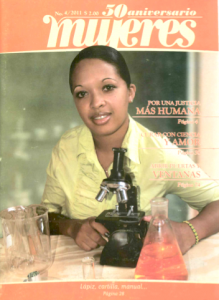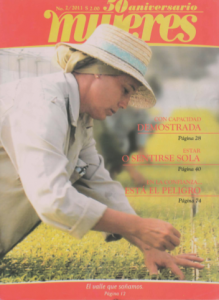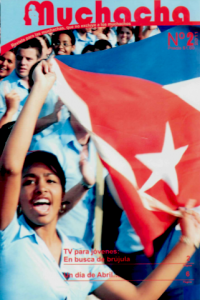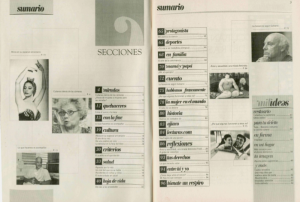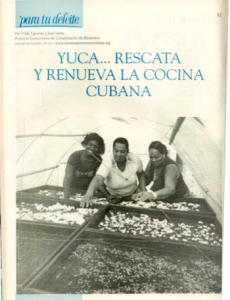The Publication of Mujeres and Muchacha and the Workings of Editorial de la mujer
April 9, 2012 by admin
On one of our last nights in Havana, Lauren and I explored the area on the other side of the Avenue Prado, a neighborhood with less tourist traffic, except perhaps the beeline to La Casa de la música. We window-shopped in a studio-gallery and admired an old church, and somewhere between the two sites, I spied an innocuous building with a little sign hanging overhead: Editorial de la mujer, or Women’s Publishing House.
As someone interested in a career in bilingual publishing and writing, I can’t say I wasn’t curious. Peeking in, face to glass, I saw a simple looking lobby, save for its walls covered in a montage of magazine covers. Each issue bore one of two titles—Mujeres or Muchacha—and each cover featured a different woman, a sampling that seemed as colorful as José Martí’s vision.
I had a hunch that these two magazines plastered on the walls were institutions of the revolution: probably to create a literary space for women and promote awareness about local and global women’s issues. Still, I came back the next morning hoping to hear about the magazines from a primary source, not just speculation. The secretary seemed a little surprised at my walk-in, but she was excited to put me in touch with two assistant editors, Raquel and Selma (I’m not sure about the name of the latter. It’s a little botched in my notes). As I waited for them to come down, the secretary told me that the headquarters for the magazine there on Calle Galiano was almost entirely self-sufficient; everything was done in that building, except for the printing which was outsourced to the same printer that produces Granma. During the brief explanation, Raquel and Selma came down from their offices and let me give interviews.
Mujeres is a government-operated magazine—a new issue appearing quarterly—produced with women in mind, but “does not exclude men either” (Raquel; translation mine). The magazine is one of the most palpable results of the efforts of the FMC, the Federación de Mujeres Cubanas, or in English, The Federation of Cuban Women. In fact, according to information on its website, the magazine is the self-proclaimed “heart of the FMC” (“¿Quiénes Somos?”). Mostly subsidized by the government, each issue is sold at two national pesos in kiosks, bookstores and newsstands all across the island.
According to the women with whom I met, the magazine circulates 60,000 print copies, but these assistant editors estimate the readership of Mujeres at 130,000. I learned that there are ten staff writers, of which one is male, but it is not unheard of for the magazine to accept a few articles from freelancers or other governmental organizations. I was interested in Raquel and Selma’s roles at the magazine. They do much of the administrative work. Both women arrived at the magazine through internships set up in conjunction with the University of Havana.
Currently, each publication of the magazine fills 96 pages with articles falling under one of many sections. Glancing at a table of contents, it is obvious that the publication covers topics as diverse as News, Domestic Duties, Health, Sports, Literature, Let’s Be Honest (Sexual Health), Women in the World, History, Reflections (as translated from the image above) and many more. Within each of these categories, there are anywhere from one to seven articles.
The history of this magazine is an interesting one. Began in 1961, Mujeres celebrated its 50th anniversary last year with four special issues, each featuring a little history of the magazine as detailed by the Editor-in-Chief, Isabel Moya Richard. She writes in the fourth issue in this series that the past fifty years have allowed for the magazine to become a forum for Cuban women and that the magazine has attempted to diversify its readership over the course of the years (2011, No.4).
During my interviews, I dug a little deeper into this past. The magazine grew from its beginning as Vanidades, which first featured as its cover photo a headshot of an Afro-Cuban woman. Though we may consider this a liberal choice, the content of the magazine was more conservative than it is today. Raquel mentioned that it was originally aimed at a family woman, in other words, a housewife. Its articles focused on romance, fashion, and the woman as the nucleus for the family.
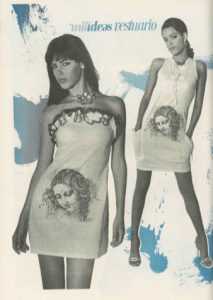
The magazine still discusses romance, fashion and domestic life, but those are just components to a well-rounded whole (2010, No.3).
Over the years, the magazine made the decision to cater to the shifting role of the revolutionary woman and to focus on a wider audience. Selma said that with sections as different as Sports and Beauty, it might encourage women interested in many non-traditional fields to pick up a copy.
The other fact I found interesting about the history of Mujeres was its hiatus during the Special Period when the government had no money to supply to the publication. The assistant editors did not remember for how long it was closed (probably seven to ten years, they guessed), but they said it reopened in April 2001. Shortly after came the development of Muchacha, which has an estimated readership of 100,000. The magazine is similar to its parent in that it covers a variety of topics, but it is aimed at girls 10-15. I am reminded of magazines like Seventeen and Teen Vogue.

The cover of the 2011 No. 4 edition of Muchacha magazine. Its cover story about skateboarding examines a hobby traditionally thought of as feminine.
Still, Muchacha caters to more girls than the niche market interested in fashion and traditionally feminine subjects. It contains book reviews, information about different careers and articles about well-known Cubana role models. It is also interesting to note its tagline, which recalls what Raquel said earlier in the interview: “Revista para muchachas, que no excluye a los muchachos.” It aims to make itself accessible to many children, boys included.
I did not ask Raquel or Selma where they see the magazine heading in the future, but as I have continued to research Mujeres, I have found significant evidence that the magazine hopes to orient itself to the Digital Age. In the last issue of the 2011 series, the Editor in Chief writes:
“We would like to expand the readership of Mujeres, but at this time, paper is scarce and expensive. We want to broadcast ourselves with new forms of communication to spread our message. When the magazine was founded, we were still using engravings as a technology; today, everything is digital. But more important than keeping uptodate, we aim to always be here for you. As Fito Páez once said, “Even if satellites fail, I’ll be there to offer my heart” (2011, No.4; translation mine).
Happy belated International Women’s Day everyone!
Sources:
Muchacha [Federación de la Mujer Cubana] Nov.-Dec. 2011, No.4. Print.
Mujeres [Federación de la Mujer Cubana] Aug.-Sept. 2010, No.3. Print.
–Nov.-Dec. 2010, No.4. Print.
–May-June 2011, No.2. Print.
–Nov.-Dec. 2011, No.4. Print.
“¿Quiénes Somos?” Revista Mujeres. Federación De La Mujer Cubana. Web. 3 Apr. 2012. <http://www.mujeres.co.cu/revista.asp>.
Raquel, Selma. “Editorial De La Mujer.” Personal interview. 16 Mar. 2012.
Teen Vogue Cover May 2012. Digital image. Teen Vogue. Vogue, May 2012. Web. 3 Apr. 2012. <http://www.teenvogue.com/magazine/covers#slide=1>.
Vanidades Cover November 1959. Digital image. Cuba Collectibles. Web. 3 Apr. 2012. <http://www.cubacollectibles.com/cuba-V-59-11-01-Vanidades.html>.
Leave a Reply
You must be logged in to post a comment.

